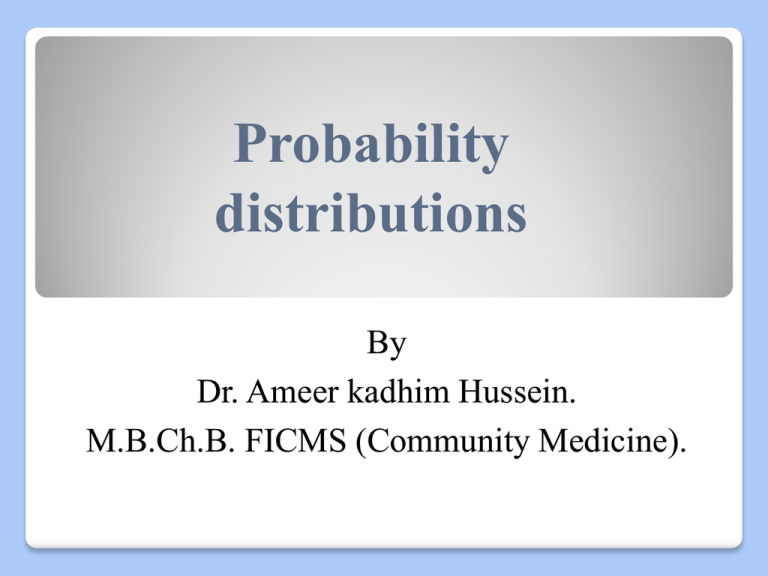Probability distributions By Dr. Ameer kadhim Hussein.
advertisement

Probability distributions By Dr. Ameer kadhim Hussein. M.B.Ch.B. FICMS (Community Medicine). Probability distributions 1.Discrete probability distributions are the binomial distribution and Poisson distribution. 2. A continuous probability distribution is a probability density function. The area under the smooth curve is equal to 1 and the frequency of occurrence of values between any two points equals the total area under the curve between the two points and the x-axis . The normal distribution The normal distribution is the most important distribution in biostatistics. It is frequently called the Gaussian distribution. It is used for continuous variables . The two parameters of the normal distribution are the mean (µ) and the standard deviation (σ). The graph has a familiar bell-shaped curve. The normal distribution Graph of a normal distribution (Gaussian distribution) 1. It is symmetrical around the mean . 2. The mean, median and mode are all equal. 3. The total area under the curve above the x-axis is 1 square unit. Therefore 50% is to the right of mean and 50% is to the left of mean. 4. Perpendiculars of: ±1 (σ) contain about 68%; ±2 (σ) contain about 95%; ±3 (σ) contain about 99.7% of the area under the curve. Relationship between the normal curve and the standard deviation: frequency All normal curves share this property: the SD cuts off a constant proportion of the distribution of scores:- 68% 95% 99.7% -3 -2 -1 mean +1 +2 +3 Number of standard deviations either side of mean The standard normal distribution A normal distribution is determined by µ and σ. The normal distribution creates a family of distributions depending on whatever the values of µ and σ are. The most important member of that family is the standard normal distribution which has µ =0 and σ =1. Standard z score The standard z score is obtained by creating a variable z whose value is Given the values of µ and σ we can convert a value of x to a value of z and find its probability using the table of normal curve areas. Finding probabilities a. What is the probability that z < -1.96? (1) Sketch a normal curve (2) Draw a line for z = -1.96 (3) Find the area in the table (4) The answer is the area to the left of the line P(z < 1.96) = .0250 Finding probabilities b) What is the probability that z > 1.96? (1) Sketch a normal curve (2) Draw a line for z = 1.96 (3) Find the area in the table (4) The answer is the area to the right of the line; found by subtracting table value from 1.0000; P(z > 1.96) =1.0000 - .9750 = .0250 What is the probability that (-1.96 <z < 1.96)? P(-1.96 < z <1.96) = 0.9750 – 0.0250 = 0.95 Example : If Z is a standard normal distribution, then P( Z < 2) = 0.9772 is the area to the left to 2 and it equals 0.9772. 2 19 Example: P(-2.55 < Z < 2.55) is the area Between -2.55 and 2.55, Then it Equals P(-2.55 < Z < 2.55) =0.9946 – 0.0054 = 0.9892. Example: P(-2.74 < Z < 1.53) is the area Between -2.74 and 1.53. P(-2.74 < Z < 1.53) =0.9370 – 0.0031 = 0.9339. -2.55 -2.74 0 2.55 1.53 20 Example : P(Z > 2.71) is the area to the Right to 2.71. So, P(Z > 2.71) =1 – 0.9966 = 0.0034. 2.71 21 Given the following probabilities. Find Z1: 1. P(z ≤ Z1)= 0.0055 2. P(z1≤ z ≤ 2.98)= 0.1117 0.9986-0.1117= 0.8869 z1= -2.54 Z1= 1.21 How to transform normal distribution (X) to standard normal distribution (Z)? This is done by the following formula: z x Example: If X is normally distributed with µ = 3, σ = 2. Find the value of standard normal Z, If X= 6? Answer: x 63 z 1.5 2 Example Suppose that systolic blood pressure among teachers is approximately normally distributed with mean of 140 and standard deviation of 50. Find the probability that a teacher picked at random will have a systolic blood pressure less than 100. We follow the steps to find the solution. (1) Write the given information µ = 140 σ = 50 x = 100 (3) Convert x to a z score P(X<100) = P(Z<100-140/50) = P(Z< -0.8) (4) P (z < -0.8) = 0.2119. (5) Complete the answer: the probability that a teacher picked at random will have a systolic blood pressure less than 100 is 0.2119. Example: In a study of children ages 8 to 15 years. The researchers found that the amount of time children spend in the upright position followed a normal distribution with mean of 5.4 hours and standard deviation of 1.3. If a child selected at random ,then 1-The probability that the child spend less than 3 hours in the upright position 24-hour period P( X < 3) = P(Z < 3 5.4 1.3 ) = P(Z < -1.85) = 0.0322 ------------------------------------------------------------------------2-The probability that the child spend more than 5 hours in the upright position 24-hour period P( X > 5) = P(Z > 5 5.4 1.3 ) = P(Z > -0.31) = 1- 0.3783= 0.6217 ----------------------------------------------------------------------- 4-The probability that the child spend from 4.5 to 7.3 hours in the upright position 24-hour period P( 4.5 < X < 7.3) = P( 4.5 5.4 1.3 = P( -0.69 < Z < 1.46 ) = 0.9279 – 0.2451 = 0.6828 < Z< 7.3 5.4 ) 1.3 Skewed Data Data may have a positive skewness (long tail to the right, or a negative skewness (long tail to the left). Kurtosis Kurtosis indicates data that are bunched together or spread out. Data that are bunched together give a tall, thin distribution which is not normal. This is called leptokurtic. Data that are spread out give a low, flat distribution which is not normal. This is called platykurtic. Kurtosis Thank you







